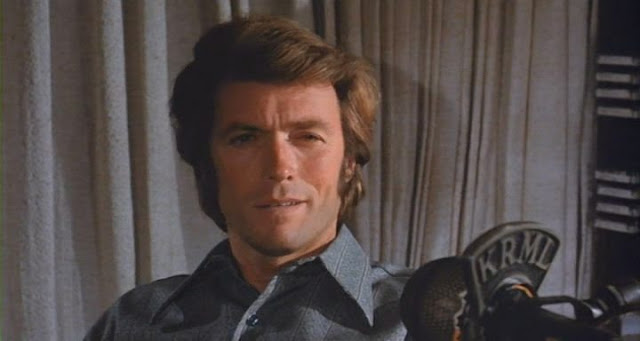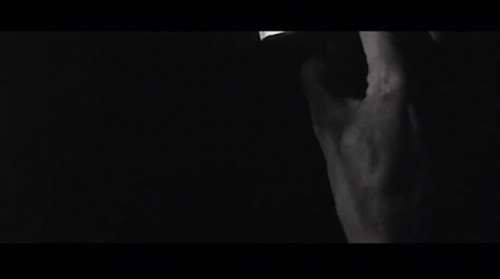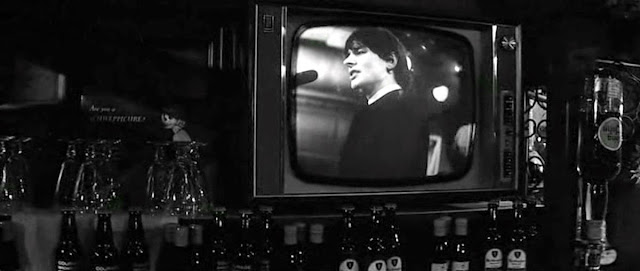 |
| Jessica Walter is shag-adelic & psycho in 'Play Misty For Me.' Clint Eastwood's a DJ who gets spun! |
Play Misty for Me
scared the life out of me as a ‘70s Yooper kid. After watching Misty again, 40-something years later,
this slasher thriller may seem tame to today’s audiences. The 1971 suspense
film still startles, thanks to no-frills storytelling and a thrilling turn by
Jessica Walter as the scary woman scorned.
 |
| 'Misty,' made on a shoe-string and made a mint. Clint starred as'Dirty Harry' the same year, the box-office equivalent of Fort Knox. |
Clint
Eastwood stars as Dave Garver, a dreamy-voiced DJ in Carmel, CA. Dave spins
records, recites poetry, and generally turns his listeners on. The latter
certainly holds true for Dave’s biggest fan, who regularly calls to make the
title request. A “chance” encounter at a local bar leads DJ Dave and # 1 fan
Evelyn Draper to spend the night together—as the then-popular Stones song goes.
For Dave, it’s a casual encounter, but for Evelyn, life or death—his! Dave is
on hiatus with his hippie girlfriend, Tobie, who wants commitment. Their
relationship is on the rocks because of his roving eye. Dave seems to shrug off
the serial shagging on his part, while bitching that Tobie always has—roommates!
Perhaps they put a crimp on the couple’s alone time…a good thing she doesn’t
live in a commune. While Dave begs Tobie for another chance, he still placates needy
Evelyn with one more session of pity sex. Dave tries to make the break final, but
his #1fan turns out to be fanatic. Evelyn takes “slash and burn” tactics to a
new level.
 |
| Clint Eastwood as Dave, Carmel's sexy DJ who meets his #1 fan... fanatic. |
Star
Clint Eastwood, in his directorial debut, filmed Misty on location in Carmel, CA, his home all these years. Eastwood
has always been a lean machine when it comes to keeping his films simple and
under budget. No ego-maniac epics or wasted money on Clint’s resume. Eastwood shot the movie in a number of homes,
restaurants, bars, and even the local radio station—no sets or process shots
here. There’s also the natural beauty of the Pacific coast, well-utilized here.
According to Jessica Walter, Clint requested that the female stars kept their
makeup and clothes simple. Clint didn’t want female leads Walter and Donna
Mills slathered in standard studio makeup. The clothes budget reflected the
characters’ lifestyles. Though it’s easy to laugh at Misty’s ‘70s mod hairdos and duds—that’s what people were wearing
at the time.
Clint,
with his soft voice, is well-cast as the DJ and playboy. After the swinging
‘60s, baby boomers were heading into the “me decade.” It always amuses me to
see stars from the prior generation, who came of age in the ‘50s, sporting long
hair, beads, and groovy threads. Clint was 41 here, a long way from Rowdy
Yates. Whether intended or not, Dave’s aging Peter Pan DJ actually adds depth to
Clint’s characterization. DJ Dave has played both sides to the middle for too
long, and now he is cock-blocked by a one night stand who won’t say goodbye.
 |
| Jessica Walter as Evelyn Draper, who wields a knife with diva gusto like Joan Crawford with an ax in 'Strait-Jacket!' |
Clint
Eastwood is a generous superstar when it comes to sharing the screen—no Barbra
Streisand tactics of hiring big name supporting casts, who then get edited down
to cameos. Clint seems secure enough to let talented co-stars shine, especially
his female stars. Eastwood basically hands Play
Misty for Me to Jessica Walter on a silver platter. As Evelyn Draper,
Walter has one of those showy, dramatic roles that would have nabbed an Oscar
nomination a decade or two before. Draper is a throwback to an old-school movie
diva role that Joan Crawford might have played—1947’s Possessed meets ‘64’s Strait-Jacket?
Jessica certainly has some of Joan’s wild-eyed, husky-voiced intensity. Evelyn
Draper goes from sassy and sexy to needy and nuts in a blink of an eye, and
Walter takes us on a wild ride. Evelyn Draper is really a younger, sexy version
of all the star turns in “hag horror” movies from the ‘60s. But Misty was released in the early ‘70s,
when realism and/or British actresses seemed to get most of the Oscar nods.
Still, Walter got raves and a Golden Globe nomination—and her performance is
right up there with Arrested Development’s
loony Lucille Bluth. The actress has said that the key to making Evelyn Draper
believable—and scarier—was to play her as not thinking she was crazy.
 |
| Donna Mills as Tobie, Clint's hippie chick artist with a Brady Bunch shag. |
Donna
Mills, later celebrated as evil Abby Ewing on Knots Landing, is warm and sensible as Tobie Williams, Clint’s cool
but fed-up hippie chick artist. Unfortunately for Mills, she gets saddled with
most of the era’s “hip” dialogue. While pondering their relationship, Mills gets to recite
clinkers even more eye-rolling than from that other Pacific coast free spirit artist,
Liz Taylor in The Sandpiper.
Unlike
its remake rip-off, Fatal Attraction,
there are no pretensions with Play Misty
for Me; it’s just a well-made, down-and-dirty thriller. Except for the ‘70s
styles and some old-school “character-defining” dialogue, Misty feels modern and direct. Play
Misty for Me, like Psycho, was
bankrolled by Universal Studios for just under a million dollars, over a decade
later. Though not the classic or blockbuster that was Psycho, Misty made a mint
at the box-office. Misty marked the beginning
of a long, increasingly distinguished directorial career for Clint Eastwood. Play Misty for Me is most memorable for
the all-stops-out performance by Jessica Walter, who should have become a major
movie star after her turn as evil Evelyn Draper.
FYI: I put all the movie overflow on my public FB movie page.
Check it out & join! https://www.facebook.com/groups/178488909366865/
 |
| Lucille Bluth, before she switched to martinis! |

























